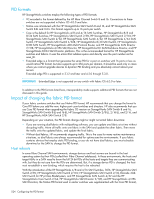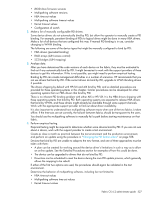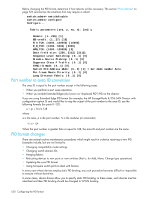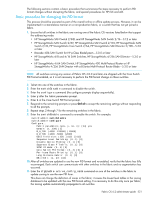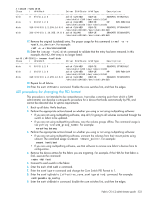HP StorageWorks 8/80 HP StorageWorks Fabric OS 6.2 administrator guide (5697-0 - Page 532
Changing the PID format
 |
View all HP StorageWorks 8/80 manuals
Add to My Manuals
Save this manual to your list of manuals |
Page 532 highlights
Changing the PID format Whether it is best to perform an offline or online update depends on the uptime requirements of the site. Following are some aspects of offline and online changes: • An offline update must have all devices attached to the fabric be offline. • With careful planning, it should be safe to update the core PID format parameter in a live, production environment. This requires dual fabrics with multipathing software. Avoid running backups during the update process, as tape drives tend to be very sensitive to I/O interruption. The online update process is intended only for use in uptime-critical dual-fabric environments, with multipathing software (high-uptime environments should always use a redundant fabric SAN architecture). Schedule a time for the update when the least critical traffic is running. All switches running any version of Fabric OS 3.1.2 and later or 4.2.0 and later are shipped with the Core Switch PID format enabled, so it is not necessary to perform the PID format change on these switches. Migrating from manual PID binding (such as persistent binding on an HBA) to manual WWN binding and upgrading drivers to versions that do not bind by PID can often be done before setting the core PID format. This reduces the number of variables in the update process. Changing the PID format online The following steps are intended to provide SAN administrators a starting point for creating site-specific procedures. 1. Back up all data and verify backups. 2. Verify that the multipathing software can automatically switch over between fabrics seamlessly. If there is doubt, use the software's administrative tools to manually disassociate or mark offline all storage devices on the first fabric to be updated. 3. Verify that I/O continues over the other fabric. 4. Disable all switches in the fabric to be updated, one switch at a time, and verify that I/O continues over the other fabric after each switch disable. 5. Change the PID format on each switch in the fabric. 6. Re-enable the switches in the updated fabric one at a time. In a core/edge network, enable the core switches first. 7. After the fabric has reconverged, use the cfgEnable command to update zoning. 8. Update the bindings for any devices manually bound by PID. This might involve changing them to the new PIDs, or preferably changing to WWN binding. For any devices automatically bound by PID, two options exist: a. Execute a custom procedure to rebuild its device tree online. Examples are provided in the "Port number to area ID conversion" on page 530 section of this chapter. b. Reboot the device to rebuild the device tree. Some operating systems require a special command to do this, for example boot -r in Solaris. 9. For devices that do not bind by PID or have had their PID binding updated, mark online or reassociate the disk devices with the multipathing software and resume I/O over the updated fabric. 10. Repeat with the other fabrics. Changing the PID format offline The following steps are intended to provide SAN administrators a starting point for creating site-specific procedures. 1. Schedule an outage for all devices attached to the fabric. 2. Back up all data and verify backups. 3. Shut down all hosts and storage devices attached to the fabric. 4. Disable all switches in the fabric. 5. Change the PID format on each switch in the fabric. 528 Configuring the PID format




